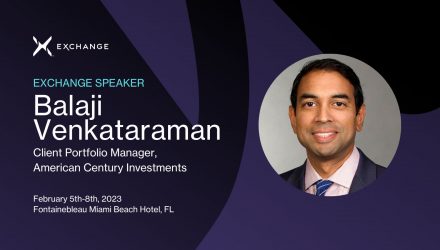The last year’s debate may have been whether inflation was sticky or not, but really, it’s the debate itself that seems to be the stickiest. It’s a top concern for advisors and their clients and was the subject of the How to Tackle Inflation panel at Exchange ETFs in Miami on Monday, hosted by ETF Think Tank Director of Research Cinthia Murphy.
Speaking on the panel, American Century Investments client portfolio manager Balaji Venkataraman and Hartford Funds head of client portfolio management Bill Pauley took on the topic from fixed income and equity angles, respectively.
For Venkataraman, with the Fed still hunting inflation and creating volatility with rate hikes, a big part of the conversation for 2023 will be how to manage not only inflation but also an economic slowdown coming from those rate hikes.
“I think that’ll be a big part of the conversation in 2023 is, how do you invest in a way that can tackle both of those things at the same time?” Venkataraman said. “A lot of how we’re investing is a reaction to what the Fed is thinking, what the Fed is projecting, and what the Fed is doing. But what’s the Fed basing its actions on? It’s the impacts to the real economy to everyday people from inflation.”
“They’re going to keep tightening because they want to bring that down and want that real rate to be at least a break-even between economic growth and inflation,” Venkataraman continued. “So they’ll probably be ok with slight negative real growth for the foreseeable future, call it 12 to 18 months, but over time, over the two plus year timeframe, they’ll want to see that sort of real positive growth come back to the economy.”
Predictions Are Tough
Pauley qualified his predictions with reference to the Yogi Berra proverb, “predictions are tough, especially about the future.” That said, he pointed to an average of five to seven years for past inflationary periods, which have mostly been started by war spending – like the war on COVID – and ended by recessions.
While the resulting recessions don’t last for the same amount of time as the inflationary periods, they do include inflationary aftershocks that the Fed may raise rates to tame, possibly adding further economic contractions.
In terms of client responses to inflation, each panelist had their takes – to Venkataraman, the situation reflects a “coin flip” from 2022 for bonds which struggled mightily last year with concerns about rate risk abounding, while this year, those concerns have settled significantly.
“The rate risk has subsided meaningfully because the fixed income market tends to price in where the Fed is going well before the Fed gets there. And that’s why we’ve seen a decline in yields here today,” Venkataraman said.
A Bond Market Defense
Venkataraman also came to the defense of the bond market in response to a point from Murphy about bonds perhaps mispricing inflation, pointing out that while some areas like the 10-Year Treasury are very representative thanks to how much they’re traded, others may be less so. That’s also something that’s been indicated by 10-Year Treasury yields dropping almost 100 basis points from a 4.25% yield a few months ago, reflecting cooling inflation.
As for solutions to inflation in client portfolios, Venkataraman pointed to high-quality investment-grade corporates as an option to watch for investors to lock in a solid yield over the next year. He did qualify that, however, with an observation that credit risk may become a bigger risk this year, too.
For Pauley, equities investors may want to look to value stocks specifically, as value tends to do well not only in rising inflationary periods but also in high and declining periods. Value stocks also work well in recessions, not including the COVID-induced recession, which may empower a value outlook to work well whether the Fed manages a soft landing or not.
For more coverage of the Exchange conference, please visit VettaFi | ETF Trends.


